Sixteen of the best American modern preservation projects selected as 2024 Modernism in America Awards winners
By Josh Niland|
Wednesday, Sep 11, 2024

Related
The hard-fought efforts and dedication of preservationists across the country have been honored through the 2024 edition of Docomomo’s annual Modernism in America Awards.
This year, a total of 16 projects were selected to earn Award of Excellence and Citation of Merit distinctions. Projects from ten states and Oslo, Norway, made up the list of honorees. Leading the field was the re-installed Aluminaire House in Palm Springs and the restored Lever House in Manhattan. A particular emphasis was placed on those included in the Commercial Design category, considering the lingering "questions" that loom over the typology in the post-Covid era.
"All of these projects are highly complex. They required extraordinary commitment and dedicated individuals to bring them to life. We are happy to give them the recognition they deserve," the organization's Executive Director, Liz Waytkus, stated. "It is a joy to see projects that celebrate and revitalize the diverse cultural histories of this country and increase public awareness of and access to art, architecture, and design of the Modern Movement."
This year's Awards program was judged by Gail Kennard, president of the Kennard Design Group; the Ford Foundation's Rocío Aranda-Alvarado; historian Steven Keylon; and architect/journalist James Russell. Be sure not to miss the upcoming Awards Ceremony presentation, which will be held on November 7th at the Design Within Reach Showroom in West Hollywood. A look back at last year's winners can be found here.
DESIGN AWARDS OF EXCELLENCE

Lever House
Location: New York, NY
Original Architects: Skidmore, Owings & Merrill (SOM)
Project Team: Skidmore, Owings & Merrill (Architect); Marmol Radziner (Interiors); Reed Hilderbrand
(Landscape Architect); Integrated Conservation Resources (ICR) (Conservation Consultant); Higgins
Quasebarth & Partners (Preservation Consultant); Pavarini McGovern (General Contractor); Gilsanz Murray
Steficek LLP (Structural Engineer); Stantec (Civil Engineer); Cosentini Associates (MEP); TM Light (Lighting
Designer); Edgett Williams Consulting Group (VT); DVS (Security); Cerami (Acoustics); FRONT (Enclosure);
Jacobs Doland Beer (Kitchen); LSM (Sales Office Designer); Dorma Kaba USA (Hardware); Pentagram
(Signage)
Jury comments: "A Commercial Design Award of Excellence is given to Lever House, a paragon of Modern architecture that revolutionized commercial office design upon its completion in 1952, setting a new standard for the relationship between office spaces and the urban environment. Designed by Skidmore, Owings & Merrill (SOM), its sleek, blue-green glass and steel facade contrasted starkly with the city’s traditional masonry, signaling a shift toward modern skyscraper design that influenced generations of architects worldwide. Over the years, SOM has provided ongoing stewardship of its iconic building, including a façade restoration in the early 2000s. However, after 70 years of operation, it needed a more comprehensive overhaul. The finished product includes a revitalized lobby, ground-level public plaza, new building-wide amenities, entirely modernized building systems, and a rehabilitated curtain wall. The work was completed with a level of detail indicative of SOM’s intimate knowledge of the building. In the public plaza, new long-lasting paving was installed and the ceiling was replaced in-kind. Stainless steel panels and the white marble enclosing stair towers were re-honed and polished. Moving inside, the lobby’s terrazzo flooring underwent repairs, lighting was upgraded, and the elevator vestibule feature wall of yellow Murano glass mosaic tiles were cleaned and earlier damage repaired. An invisible intervention within the curtain wall addresses condensation issues, supporting long-term preservation. Changes to the mechanical systems on the office floors contribute to new LEED Gold and WELL Platinum certification targets and allow floor space and ceiling height to be expanded, ensuring the space maintains its Class A office classification. At a time when commercial office spaces face an unclear future, Lever House once again sets an example for others to follow."

Mariners Medical Arts Building
Location: Newport Beach, CA
Original Architect: Richard Neutra
Project Team: Donaldson + Partners: Robin Donaldson (Partner in Charge), Sieglinde Pukke (Project
Manager, Principal), Charlotte Hofstetter (Project Architect); Chattel and Associates: Robert Chattel, Alvin
Nuval (Historians); Tom Nielsen, NSE (Structural Engineer); Jose Cazares, Ground Level (Landscape
Architect); Greg Lang, PLSA Engineering (Civil Engineer); Dempsey Construction Inc (General Contractor);
Aquatics Technologies (Water Feature Design Build)
Jury comments: "A Commercial Design Award of Excellence is presented to the Mariners Medical Arts Building in Newport Beach, California. Completed in 1961 by architect Richard Neutra, this trio of buildings was commissioned by a group of eleven doctors with a vision to create a medical clinic that was as welcoming and serene as it was functional. Neutra’s design successfully balanced these objectives, creating a space where nature’s calming influence and architectural clarity converge. At the heart of the complex is an open-air garden that serves as a tranquil 'lobby' for the entire facility, providing a serene passage through lush tropical plants, reflecting pools, and asymmetrically laid walkways. With the help of 22 pages of the original building drawings and lots of photographs by Julius Schulman, the original paint colors were identified and matched as closely as possible in the restoration. The first floor was originally designed to be fully accessible, although no codes were in place at the time. Neutra’s wheelchair ramp was brought up to current day code. Significant care was taken to repair the iconic sun-shading elements, including the vertical aluminum louvers and wood trellises, ensuring they continue to perform their passive cooling functions. The original roof drainage system design had problems from the start and was completely remodeled to prevent flooding issues. The rejuvenation of the building’s water features – once drained and filled – reintroduces the soothing presence of water while incorporating safety improvements that reflect Neutra’s original terrazzo design."

Former U.S. Embassy, Norway
Location: Oslo, Norway
Original Architect: Eero Saarinen
Project Team: Atelier Oslo and Lundhagem (Lead Architects); Erik Langdalen Arkitektkontor and OteroPailos Studio (Preservation Architects); LCLA Office and SLA (Landscape Architects); Paulsen & Nilsen
(Interior Designers); Bollinger & Grohmann (Engineers)
Jury comments: "A Civic/Institutional Design Award of Excellence is given for the restoration and adaptive reuse of the former U.S. Embassy in Oslo, Norway. This 1959 chancery, designed by Eero Saarinen, is a significant example of postwar Modernist architecture, embodying American values during the Cold War. Saarinen's striking design, particularly the precast concrete facades, was a technological first for Norway. Over decades, the façades had faded and deteriorated. The preservation team treated damaged areas, and the entire surface was buffed by hand, restoring the original sheen. An underground extension and a discreet rooftop addition were added to meet current needs without altering the building’s external appearance. Landmarked interiors, including the atrium and ambassador's office, were restored with sustainable materials while retaining character defining features. The U.S. State Department has been decommissioning and selling off its Modernist embassies, and many are being demolished, gutted or altered beyond recognition. Docomomo US has long advocated for preservation of these buildings, many of which are highly significant. This project is a rare example of an entire embassy building being saved and carefully restored."
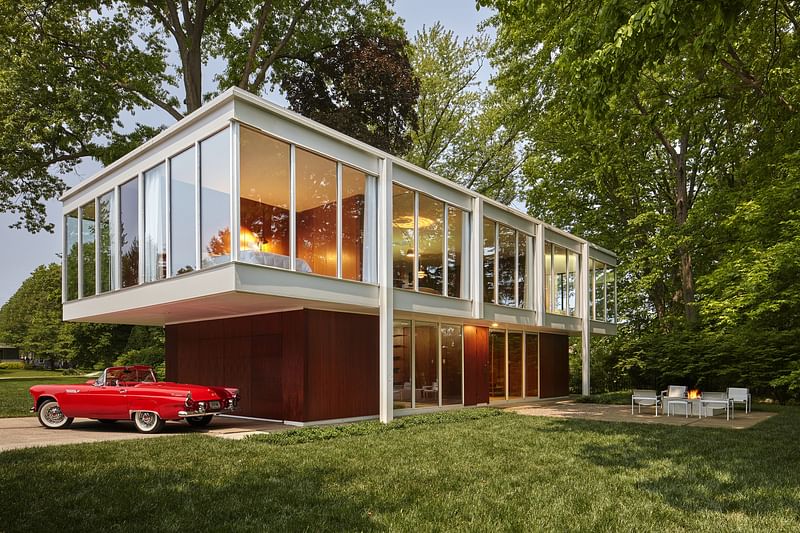
345 Glass House
Location: Berea, OH
Original Architect: Carl Droppers
Project Team: Susan Secoy Jensen, AIA; Secoy Architects, Inc. (Architect, Designer); Daniel Jensen (Project
Manager); Garrett Wehan (Design Team); Daniel Bier, PLA, ASLA (Landscape Architect); Michael O’Neal,
Wood Images (Contractor); Todd Shaw (Contractor); James Haefner (Photographer)
Jury comments: "A Residential Design Award of Excellence is given for the restoration of the 345 Glass House in Berea, Ohio. Designed by architect Carl Droppers and constructed in 1965, this International style home showcases innovation through its steel and glass construction, Vierendeel Trusses, and twelve-foot cantilevers at either end. This project was particularly commended for prioritizing retention of original material. The restoration was guided by original drawings from Droppers and structural engineer Richard M. Gensert, which were in unusually well-preserved condition. Damaged concrete was replaced with Berea sandstone slabs, matching the original grid. Interior updates included a new sandstone hearth, adjustments to original Philippine mahogany panels, and new flooring. Twenty-six damaged glass panels were replaced using dual-paned energy efficient windows and custom milled hardwood stops replicating the originals. In the kitchen, the original cabinets were restored, new matching Formica counters installed, and in a rare occurrence, the original appliances were retained and repaired. The original doors, both interior and exterior, remain throughout the home."
SURVEY AWARD OF EXCELLENCE

Docomomo US/MN Minnesota Modern Registry
Location: Minnesota
Project Team: Bobak Ha'Eri (Creator, Developer, and Researcher)
Jury comments: "The Docomomo US/Minnesota chapter’s Minnesota Modern Registry receives an Inventory/Survey Award of Excellence for its achievement in documenting Modern architecture across an expansive regional landscape. This project meticulously catalogued over 9,000 properties, distilling vast amounts of data from diverse sources into a user-friendly, evolving resource. Its centerpiece, the Registry Map, provides a rich, interactive platform showcasing structures, districts, architects, and photographic documentation of properties built from the 1920s to the 1980s. The Registry's comprehensive Works Cited, featuring more than 5,300 entries, underscores the depth and breadth of research involved, highlighting the exceptional dedication of board member Bobak Ha’Eri, who brought this ambitious vision to fruition. This initiative serves as a critical foundation for future scholarship, preservation, and public engagement with Minnesota’s Modern resources. By employing Google Maps, the Registry ensures accessibility, ease of use, and adaptability, while also facilitating future expansions and contributions. With nearly 150,000 views as of June 2024, the Registry is an invaluable asset for researchers, enthusiasts, and the public alike."

Heritage at Risk Survey 2023
Location: Miami-Dade County, FL
Project Team: Miami-Dade County Office of Historic Preservation: Jerry Bell (Assistant Director for
Planning); Sarah Cody (Historic Preservation Chief); Adrienne Burke (Principal Planner); Alex Dambach
(Planning Development Manager); Tamara McDonald (Historic Preservation Specialist); Jeff Ransom (County
Archaeologist); Shulman + Associates (Research, Mapping, Surveying, Analysis, Text): Allan Shulman
(Principal in Charge & author of main texts); Miriam Alenezi (Project Manager); Rebecca Stanier-Shulman
(Project Administrator); Tori Cohen (Graphic Designer); Luis Sanchez (Architectural drafting); Lucas Rosen
(Graphics Support); Ivo Rondinoni (Data Processing); Geo-Urban Consulting (Community Outreach): Hernan
Guerrero Applewhite (Principal); Karen Moore (Community Liaison); Jay Molokwu (Designer)
Jury comments: "An Inventory/Survey Award of Excellence is bestowed upon the Heritage at Risk Survey 2023 of Miami-Dade County, which addressed a significant gap in knowledge about buildings and resources constructed between 1941 and 1981. This survey provides a critical assessment of post-war development and its impact on the county's architectural landscape. Launched in 2021, the project integrates innovative methodologies that connect historic preservation with broader planning and development policies. It focuses on areas facing redevelopment pressures, gentrification, housing affordability challenges, and climate resiliency, while also ensuring inclusive representation of historically underrepresented communities. To define the project area, a layered series of maps were created that illustrate communities where the County has already adopted policies that incentivize development. These areas were also evaluated in relation to FEMA flood zones, and the inclusion of historically excluded communities. The survey identified 7,870 sites, with 1,200 prioritized for further study. Among these, 406 resources were deemed potentially eligible for listing in the National Register, and 15% of properties surveyed were found to be associated with historically excluded communities. The Heritage at Risk Survey highlights the architectural significance of post-war structures and provides a strategic framework for future preservation efforts."
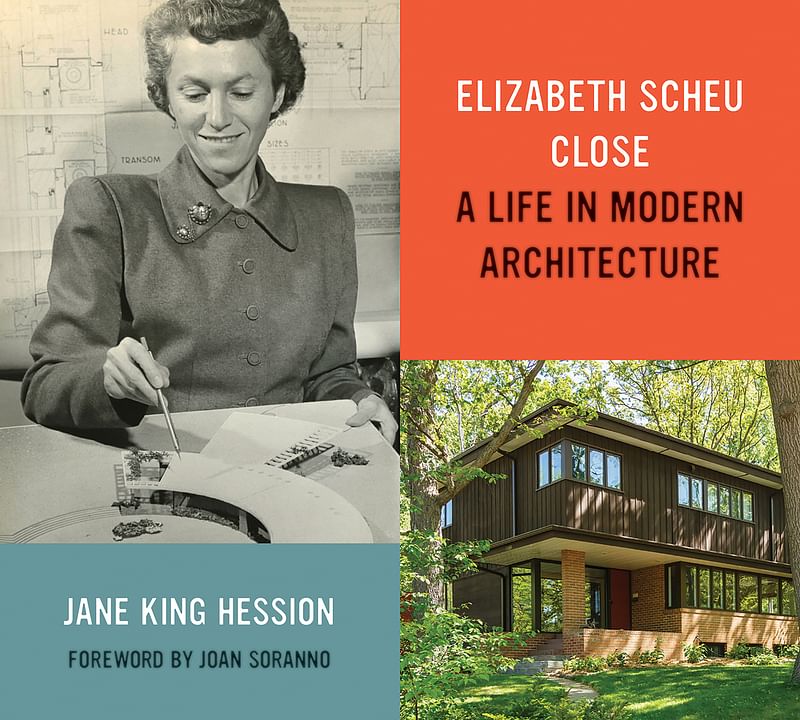
Elizabeth Scheu Close: A Life in Modern Architecture (Book and Exhibition)
Project Team: University of Minnesota Press (Publisher); Jane King Hession (Author and Curator); Joan Soranno (foreword); Pieter Martin (Senior Editor); Laura Westlund (Managing Editor); Eric Lundgren (Development and Outreach Manager); Anne Carter (Editorial Assistant); Rachel Moeller (Assistant Production Manager and Art Director); Emily Hamilton (Associate Director for Book Publishing); Heather Skinner (Publicity Director); Matt Smiley (Senior Sales Manager); Maggie Sattler (Digital Marketing Manager); Jeff Moen (Rights, Permissions, and Contracts Coordinator); Jena Sher (designer); William B. Olexy (Photographer); Goldstein Museum of Design, University of Minnesota (Exhibition Host); Lin Nelson-Mayson (Museum Director); Soo Jin Kang (Exhibition Designer); Rolf Anderson (Nominator)
Donors: Georgia Bizios; Lynda and Darel Jacobsen; Edward J. Kodet, Jr., FAIA; Mark Larson and Jean Rehkamp Larson; Michaela Mahady; Rosemary McMonigal; Lea Babcock Scherer and Jeffrey Scherer; Anne Close Ulmer, Roy M. Close, and Bob Close; James and Megan Dayton; Dale and Jan Mulfinger; Gladys and Roger Reiling
Grant Support: Beverly Willis Architecture Foundation; Graham Foundation for Advanced Studies in the Fine Arts
Jury comments: "An Inventory/Survey Award of Excellence is presented to Elizabeth Scheu Close: A Life in Modern Architecture (book
and exhibition), for its achievement in documenting the legacy of one of Minnesota’s earliest Modern architects
and one of America’s pioneering women in architecture. This project, a collaboration between author Jane
King Hession and the University of Minnesota Press, chronicles the life and work of Elizabeth 'Lisl' Scheu
Close, offering insights into her significant contributions to Modernism. The book traces her journey, from her
origins in Vienna, Austria, through her education at MIT, and her co-founding of Minnesota’s first Modern
architectural practice. It sheds light on the challenges she faced due to her gender and highlights her role in
designing more than 250 Modern residences and various public buildings that have shaped Minnesota's
architectural landscape. The accompanying exhibition, both physical and digital, broadens the reach of this
important narrative, engaging diverse audiences and fostering a deeper appreciation for Close’s work."
ADVOCACY AWARD OF EXCELLENCE

Breuer Cottage
Location: Wellfleet, MA
Original Architect: Marcel Breuer
Project Team: Peter McMahon, CCMHT Founding Director (Team Leader); Rob Warren, CCMHT Board Member (Land Conservation Consultant, Fund Raising and Financial Analyst); Jenny Monick, CCMHT Board President (Lead for Fundraising and Donor Outreach); Rick Handman, CCMHT Board Treasurer (Financial Manager); Tracy Neuman, CCMHT Board Member (Lead Grant Writer); Virginia Adams, CCMHT Board Member (National Register Nomination Consultant); Caitlin DiGiacomo, CCMHT Administrator (Data Manager); Melissa Yeaw, CCMHT Administrator; Sarah Shrewsbury, Principal, Vineyard Consulting (Lead Fundraising Consultant); Brook Valerino, Endeavor Consulting Group (Grant Researcher / Writer)
Jury comments: "An Advocacy Award of Excellence is given to the Cape Cod Modern House Trust (CCMHT), led by Peter
McMahon, for the monumental preservation victory of rescuing the Marcel Breuer-designed cottage in
Wellfleet, MA. Completed in 1949, this iconic 'long-house' merges Modernist principles with the natural
landscape of Cape Cod. As Breuer’s personal summer escape, the cottage holds immense historical and
cultural significance, as it was obtained directly from the Breuer family and for having hosted a slew of the 20th
century’s most influential artists and designers. The Cottage suffered from deferred maintenance and the high
risk associated with the real estate market on the Outer Cape. Recognizing this, CCMHT launched an
ambitious fundraising campaign, raising $1.4 million in cash. Using all options available, they also secured
$200,000 in municipal funds, a total of $400,000 in low-interest loans and borrowed the remainder to purchase
the property for $2 million, with $400,000 set aside for restoration. As the new owner, CCMHT will ensure
that the Cottage, along with Breuer’s collection of art and archives, remain accessible to scholars and the
public. This exemplary advocacy effort preserves an irreplaceable piece of Cape Cod’s cultural and
architectural history."
DESIGN CITATION OF MERIT
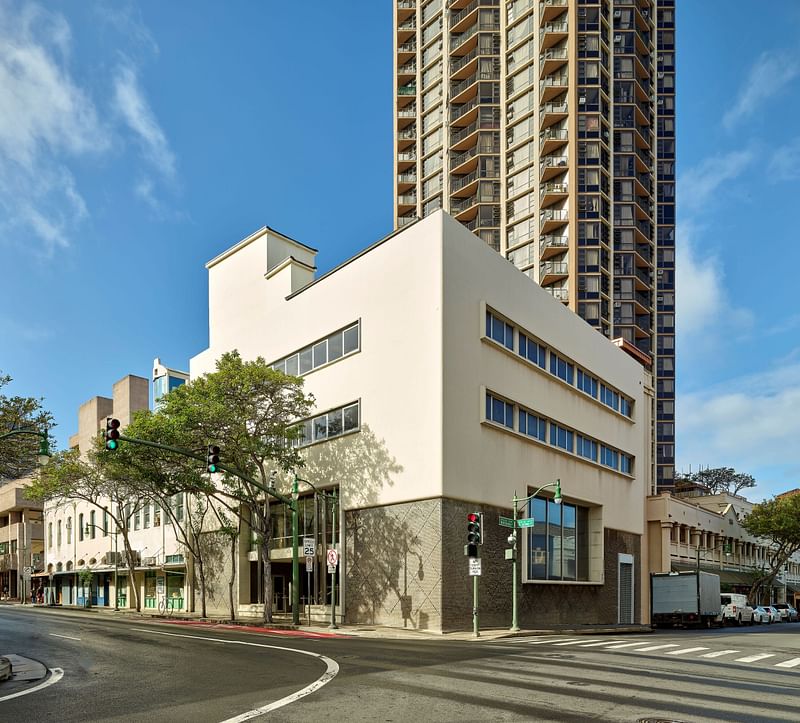
King Liberty Center
Location: Honolulu, HI
Original Architect: Vladimir Ossipoff, FAIA
Project team: Dean Sakamoto, FAIA (Architect); Don Hibbard, Ph.D. (Historic Preservation Consultant);
Andrea Brizzi (Photography)
Jury comments: "A Commercial Design Citation of Merit is given for the adaptive reuse of the King Liberty Center. Originally designed by Vladimir Ossipoff in 1952, this four-story building was the headquarters of Liberty Bank, a cornerstone institution serving the Chinatown community. Ossipoff’s design reflects its environment, combining Modern and traditional elements, and integrates local materials and cultural motifs, such as the 'Fu' symbol on its stainless-steel entry columns. The reuse project focused on transforming the former bank’s grand, double-height banking hall into a multi-purpose event space while preserving significant architectural features. Non-original elements that compromised the original design were removed, and the original terrazzo floors and hardwood millwork were restored. The mezzanine was thoughtfully upgraded to house a contemporary architectural office, repurposing materials from the same era to maintain historical continuity. This project not only revitalizes a historic structure but also honors its cultural significance, offering a renewed space that will continue to serve Honolulu’s urban core."

Donaldson Futuro
Location: Idyllwild, CA
Original Architect: Matti Suuronen
Project Team: Milford Wayne Donaldson, FAIA (Preservation Architect/Restorer); Laurie Donaldson
(Interior Design); Stuart Sawasaki, Architect MWD, FAIA (Project Architect); Eileen Magno, Architect MWD,
FAIA (Historian); Jim King, JD King Construction (Contractor); Dora L. Dillman Construction (Permit
Supervisor); Elbert Speidel (Plastic Consultant); Jim Miller, Riverside Co. Building & Safety (Inspector); Marko
Home, Desura Oy Ltd., Finland (Futuro Author); Paul McNeil, Bryon Bay, Australia (Futuro Owner/Parts);
Victoria Clarkin, Pensacola, Florida (Futuro Owner/Consultant); Eric Stover, SE, LZA Technology
(Structural Engineer); Susan Buck, Paintchips (Color Conservator); Larry Wood, San Diego Boat Movers
(Futuro Transport); Joe Sanderval, Marco Crane & Rigging (Futuro Transport); Charlie Clayton, Ajax Rock
(Concrete and Stone); Mike Duron, Power Bound Electrical (Electrical); Dan Lind, Inland Foundation
Engineering (Septic); Rigo Vazquez, Advance Fire Protection (Fire Sprinklers); Mike Clark, Woodwizard
Woodworks; Earl Siems Carpentry; Rick Chaney Plumbing; J. C. Holt Surveying.
Jury comments: "A Residential Design Citation of Merit is presented to the Donaldson Futuro House in Idyllwild, California. The Futuro was conceived in 1968 as a portable ski chalet by Finnish architect Matti Suuronen. The futuristic structure is characterized by its ellipsoid shape and reinforced fiberglass construction. Fewer than 100 were ever built, and even fewer remain today. The Donaldson Futuro was in disrepair after years of neglect and damage, including an unsuccessful demolition attempt in 2002, when Wayne and Laurie Donaldson purchased it and embarked on an extensive restoration process. After moving it from San Diego to Idyllwild, they repaired and repainted the exterior, recreated the original curved acrylic bubble windows, and conducted a structural analysis to ensure the house met modern seismic, wind, and snow load requirements. On the interior, the original Formica laminate countertops and built-in furniture were preserved, and the deteriorating asbestos popcorn ceiling was replicated using safer materials. The project faced numerous challenges, from complying with California’s stringent energy and fire safety codes, to exiting and addressing the unique structural characteristics of the Futuro."

UC San Diego Humanities & Social Sciences Building
Location: La Jolla, CA
Original Architect: Richard George Wheeler
Project Team: University of California, San Diego: Elisa Pittner, Brad Phipps (Owner); Moore Ruble Yudell:
Neal Matsuno, Jeanne Chen, Adam Padua, Martin Saavedra, Laurie Groehler, Nozumu Sugawara (Executive
Architect); Architectural Resources Group: Katie Horak, Lindsey Miller, Sarah Devan (Historic Architect);
Coffman Engineers, Inc: Mike West, Paul Stuart, Rae Ferriolo, Laura Zuill, Jon Arenz (Structural, MEP, Civil
Engineering); Simpson Gumpertz & Heger: Amy Hackney, Mike Huhtala (Waterproofing Consultant);
LandLab: Neil Hadley, Emily Gehle (Landscape Architect); Jensen Hughes, Will Fletcher (Fire/Life Safety);
Rudolph and Sletten: Andy Rogers, Dave Jesme, Syed Shah (General Contractor), Doug Ogie; Willis
Construction: Larry Willis, Mark Hildebrand (Precast Manufacturer)
Jury comments: "A Civic/Institutional Design Citation of Merit is awarded to the restoration of the Humanities and Social Sciences (HSS) Building at the University of California, San Diego, designed by architect Richard George Wheeler in 1970. As a key structure within the Muir College campus, renowned for its concentration of Brutalist buildings, the HSS Building embodies the campus’ aesthetic unity and distinct sense of place. Faced with severe deterioration of the original precast concrete façade due to coastal exposure and systemic material flaws, UC San Diego undertook a comprehensive façade replacement project in 2020. This effort involved the reproduction of the original concrete panels, ensuring visual consistency with the historic design while meeting contemporary performance standards, following rigorous regulatory approvals, and adhering to the Secretary of the Interior’s Standards for Rehabilitation. Completed in just 16 months, the project demonstrates how material replacement can effectively address critical structural issues without compromising architectural integrity."
INVENTORY/SURVEY CITATION OF MERIT
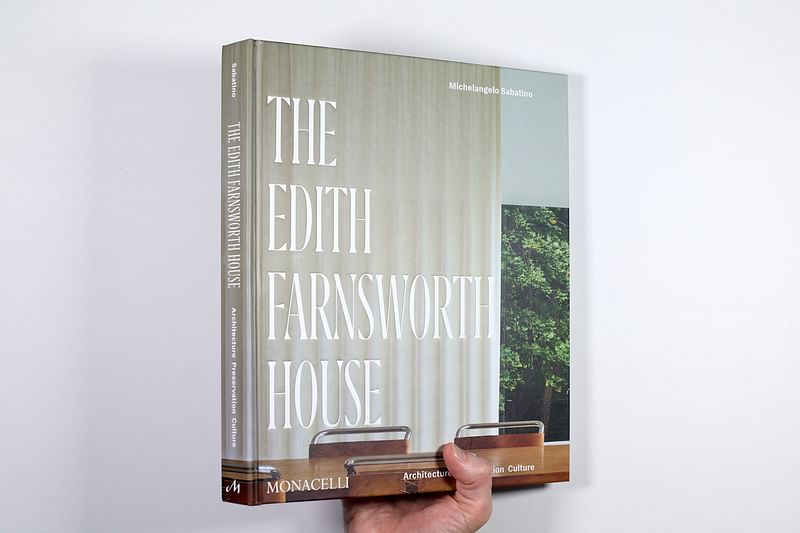
The Edith Farnsworth House Book
Project Team: Michelangelo Sabatino (Author); Chris Grimley, SIGNALS (Graphic Design); Scott Mehaffey (Edith Farnsworth House/National Trust for Historic Preservation); Dietrich Neumann; Hilary Lewis; Ron Henderson; Alan Rapp; The Monacelli Press (Publisher)
Client: National Trust for Historic Preservation
Jury comments: "An Inventory/Survey Citation of Merit is presented to The Edith Farnsworth House book (The Monacelli Press),
authored by Michelangelo Sabatino, with contributions by Scott Mehaffey, Dietrich Neumann, Ron
Henderson, and Hilary Lewis. Although much scholarship exists on the iconic house in Chicago’s suburbs by
Mies van der Rohe, there was a gap in knowledge and misconceptions surrounding its patron and client, Dr.
Edith Farnsworth. This publication, designed by Chris Grimley, brings to light her pivotal role, a
perspective often overshadowed in other Mies-centric narratives about this modern country house. Combining
scholarly insight with visual artistry, the book includes excerpts from Farnsworth’s unpublished memoir,
interviews with Mies’s grandson Dirk Lohan and the house’s second owner Lord Peter Palumbo, as well as
photographs from Hedrich Blessing, Hiroshi Sugimoto, and Jack Boucher, as well as documentation of cultural
collaborations with renowned artists and designers."
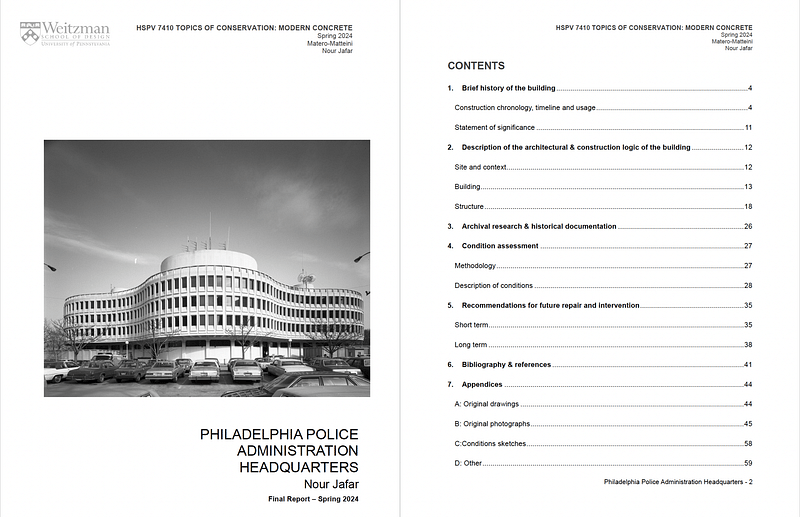
Student Project: Philadelphia Police Administration Headquarters
Location: Philadelphia, PA
Project Team: Nour Jafar (Student and Author); Frank Matero and Irene Matteini (Professors)
Jury comments: "An Inventory/Survey Citation of Merit is given for Nour Jafar’s student research project on the Philadelphia Police Administration Building, also known as the 'Roundhouse.' This paper is a notable contribution to the discourse on architectural preservation and social justice which surrounds the building. Jafar documents the technological advancements and material innovations that characterize the Roundhouse and engages critically with its fraught history as a site of violence and trauma. The paper explores the potential consequences of redevelopment, particularly its impact on surrounding communities, and proposes thoughtful conservation strategies that balance the building’s architectural significance with the need for reparative justice. By integrating historical documentation with contemporary social concerns, this research provides an essential resource for understanding the Roundhouse’s role in Philadelphia’s post-war architectural landscape and its ongoing significance."
ADVOCACY CITATION OF MERIT
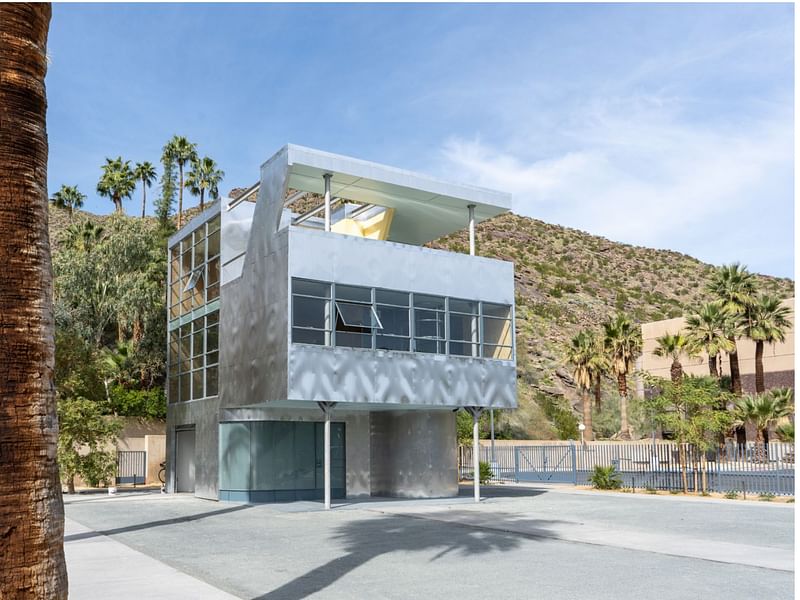
Aluminaire House
Location: Palm Springs, CA
Original Architects: Lawrence Kocher and Albert Frey
Project Team: (In chronological order reflecting the 37 years over which advocacy efforts took place) Jon Michael Schwarting (Campani and Schwarting Architects, Professor Emeritus NYIT, Aluminaire House Project, Aluminaire House Foundation); Frances Campani (Campani and Schwarting Architects, Associate Professor NYIT, Aluminaire House Project, Aluminaire House Foundation); Dr. Julio M. San Jose (Dean, School of Architecture, NYIT–deceased); Mr. Michael Lynch (Director, Division of Historic Preservation Services, NY State Department of Parks, Recreation and Historic Preservation);120 NYIT architecture students who worked on the Aluminaire House in classes for 10 semesters from 1988-1992; Paul Field (Contractor, NYIT adjunct assistant professor); Elise Quasebarth, Higgens and Quasbarth LLC (Historic Structures Report); Dr. Kenneth Frampton, (Professor of Architecture, Architectural historian and critic, Aluminaire House Foundation); Walter Chapman (Contractor, 2000 reconstruction and 2012 deconstruction); Mark Davis (Modernism Week, Aluminaire House Foundation); all members of the 2014-2020 California Committee of the Aluminaire House Foundation; Louis Grachos (Former Director, Palm Springs Art Museum); Adam Lerner (Executive Director/CEO, Palm Springs Art Museum); Leo Marmol (Architect, Marmol Radziner, Trustee Palm Springs Art Museum); D.W. Johnston, (Contractors, Palm Springs reconstruction).
Jury comments: "An Advocacy Citation of Merit is presented to the Aluminaire House, designed by Lawrence Kocher and Albert Frey. Originally conceived as an exhibition piece for the 1931 Allied Arts and Industry and Architectural League Exhibition in New York City, the Aluminaire House showcased mass-produced building materials in a modern, repeatable form. It was never intended as a permanent structure, but at the end of the exhibition, architect Wallace Harrison purchased the building and relocated it to his property, thus beginning its long journey. In the early 1990s it was moved to the NYIT Central Islip campus in an effort to save it, led by key figures Professors Michael Schwarting and Frances Campani. When the campus later closed, the building went into storage, but it was not forgotten. A presentation by Schwarting and Campani in 2014 kicked off a renewed effort, led by Mark Davis of Modernism Week, to bring the house out of storage and relocate it to Palm Springs. Advocacy work continued and in February 2020 the Palm Springs Art Museum agreed to accept the house as part of its permanent collection. After a Covid-19 delay, the Aluminaire House was carefully and accurately reassembled. The original structural materials of aluminum columns, girders and beams, steel girts to frame the walls and the steel windows all remain in place. The House is visible from the street, and the grounds are open to the public when the Museum is open. In a suitable homage, Frey House 2, that Frey built for himself in 1964, sits on the mountain behind, looking down on the Aluminaire House."
CITATION FOR ART PRESERVATION
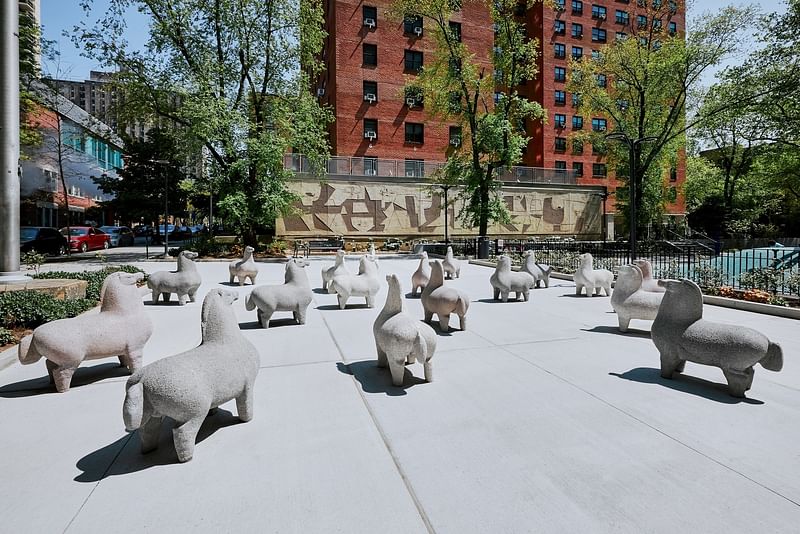
Concrete Play Horses
Location: New York, NY
Original Artist: Costantino Nivola
Project team: New York City Housing Authority (Government Partner); Monadnock Development
(Developer); Kalel Companies (Developer); Lemor Development (Developer); Community Preservation
Corporation (Investor); Community Development Trust (Investor); Jablonski Building Conservation, Inc.
(Architectural Conservator); Old Structures Engineering (Structural Engineer); SLM Architecture (Architect);
DirtWorks (Landscape Architect); Fondazione Nivola/Museo Nivola (Consultant); Monadnock Construction
(General Contractor)
Jury comments: "A Citation for Art Preservation is presented for the restoration of Costantino Nivola’s Concrete Play Horses at the Stephen Wise Towers in Manhattan. Originally installed in 1964 as part of a Modernist landscape designed by Nivola and architect Richard Stein, these eighteen abstract, cast-concrete horses served as a beloved play feature in a public housing plaza, where the residents refer to them as 'llamas.' Nivola also created an abstract expressionist sgraffito mural, cast concrete “Fountain,” “Concrete Wall,” and humanist abstract sculpture, 'The Nanny' at the site. The collection is the largest of Nivola’s public works in New York City and is believed to be unique among his public artworks in its blending of artistic techniques and forms. Over the years the horses suffered various forms of damage, and in 2021 they were hastily removed to fix a water main break, prompting their repair and reinstallation. One of the project’s main challenges was a lack of original documentation. Through research, the conservators discovered a nearly identical fiberglass 'herd' in Columbus, Indiana, which they used to recreate missing muzzles and damaged legs. Petrographic and chemical analyses guided the development of concrete mixes to match the original material, even accounting for weathering effects over the years. Old photographs and satellite imagery were used to map out the original configuration of the horses. Thanks to a committed developer, a dedicated team of conservators and talented specialists, a vital community asset has been preserved."
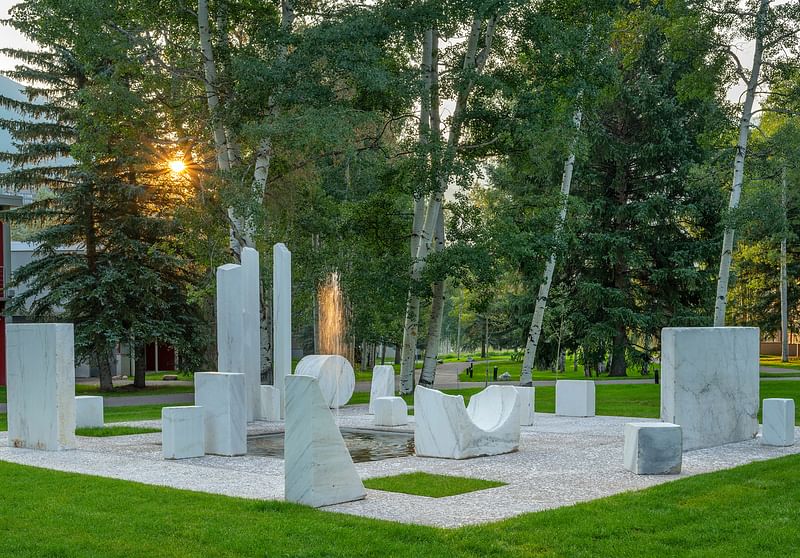
Marble Garden
Location: Aspen, CO
Original Artist: Herbert Bayer
Project Team: Design Workshop: Richard Shaw (Principal), Meg Plumb (Project Manager), Ashley Hejtmanek
(Interim Project Manager), Chris Perkes, Jessica Perreault, Shannon Sylte, Sam Daniel (Award Graphics),
Moritz Jahn (Award Graphics), Xinyu Li (Award Graphics); Lissa Ballinger, Aspen Institute (Art Curator);
KL&A (Structural Engineer); Wiss, Janney, Elstner & Associates (Stone Preservationist); GF Woods
Construction (General Contractor); Roaring Fork Landscapes (Landscape Contractor)
Jury comments: "A Citation for Art Preservation is awarded for the restoration of Marble Garden, a 1955 Modernist landscape sculpture by Bauhaus artist Herbert Bayer at the Aspen Institute. This pioneering work of land art consisting of twenty-one upright marble slabs set on a marble aggregate base, with an inset reflecting pool and fountain, was in disrepair due to poor drainage, structural instability, and the freeze thaw cycle of harsh Aspen winters. Landscape architects were tasked with saving this sculpture without knowledge from the artist about the original materials, construction methods, or documentation of the built work. Restoration plans were based on historic research, a survey, archival materials, and information gleaned during the careful deconstruction process. The stones were cleaned and returned to their original luster and foundations were stabilized. The crumbling concrete slab was replaced with matching aggregate and corrosion and water management issues were addressed. This effort was an exercise in synthesizing artistic intent, material selection, and construction methods in the context of the Modernist Movement and its relationship to Aspen, Colorado."

RELATED NEWS These are the 2023 Modernism in America Awards winners


Share
0 Comments
Comment as :